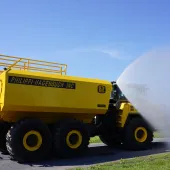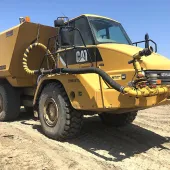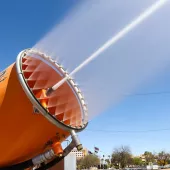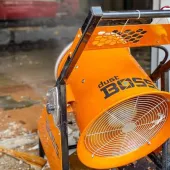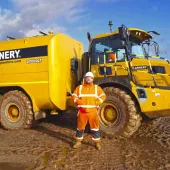Innovation in Dust Management
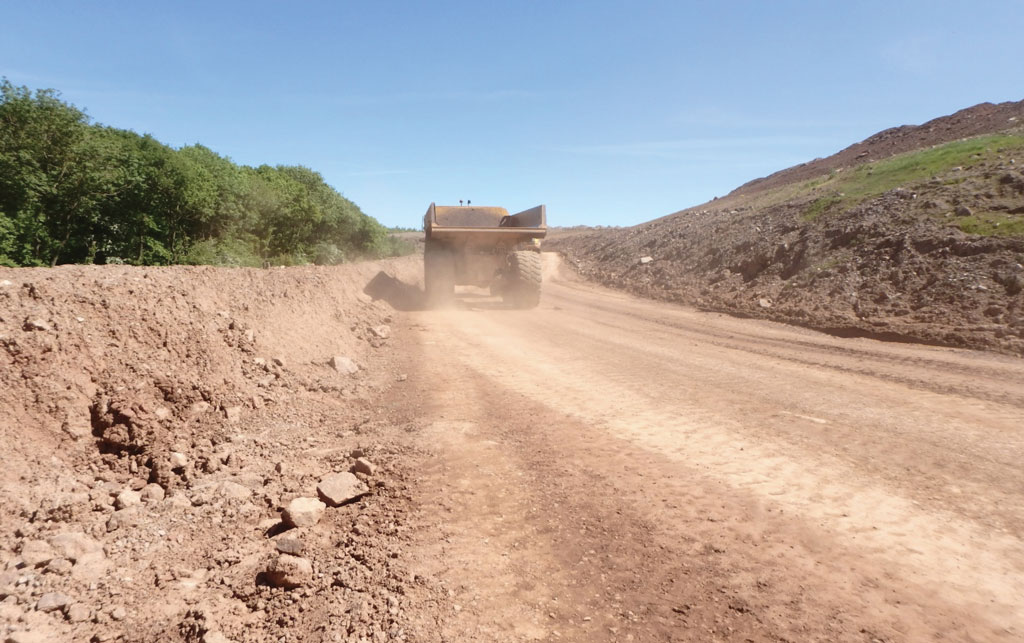
First published in the April 2019 issue of Quarry Management
Dust prediction as a basis for planning dust suppression in quarries and large earthworks – an example from Mountsorrel Quarry
By Daniel Quinn and Paul Eaton, DustScanAQ
Predicting and preventing dust emissions from minerals and other sites traditionally involves detailed knowledge of site operations, access to local weather forecasts and the availability of controls such as fixed water sprays and mobile bowsers. Sometimes such control measures are applied either unnecessarily as a blanket measure, or too late once dust is airborne and there is a risk of complaint.
This article outlines an innovative approach to predicting when there might be a need for dust suppression, potentially allowing resources to be targeted more effectively than might be the case at present. The control of water resources and energy use is appropriate for all large quarries and construction sites, especially where the need for dust control is frequently localized and/or temporary. It becomes even more important where expensive additives are used, especially if their on-site efficacy has not been tested. Continuous dust suppression is seldom required.
DustScanAQ have been working closely with Tarmac at Mountsorrel Quarry, in Leicestershire, for many years on dust, odour and air-quality matters. An Air Quality Management Area (AQMA) with respect to fine particulate matter (PM10) was declared by Charnwood Borough Council in 2011 for the area comprising the quarry and some residential properties in the neighbourhood.
Dust monitoring at Mountsorrel Quarry has involved monitoring for both nuisance dust and PM10, as well as weather, at several on- and off-site locations for both compliance and overall quarry improvement purposes. From a long interaction with the quarry management team, who take a positive and proactive approach to environmental management at the quarry, DustScanAQ have been able to develop a site-specific PM10 prediction tool that has the potential to be utilized at many other minerals and other sites.
It has long been recognized that numerous processes on aggregates sites may give rise to PM10 generation. Typical potentially dusty operations include crushing, screening, materials handling at transfer points and HGV movements, to name but a few.
Two years ago, a Turnkey Osiris real-time ambient particulate matter monitor was installed approximately 60m downwind of the asphalt and load-out area with respect to the prevailing wind direction, as shown in figure 1. This monitor is a recognized and certificated ‘indicative’ device that is connected to its own wind vane and anemometer, providing reliable ‘real-time’ directional PM10, PM2.5 and PM1 data almost instantaneously. The information is conveyed directly to the quarry management team through email alerts and daily summary reports. As a result, actions can be taken on site to address dust-generating activities far sooner than previously.
It was recognized that whilst a real-time alert-based system for PM10 monitoring can have a positive impact on PM10 levels through alert response protocols, it is inherently reactive in nature. Once an alert has been triggered the unacceptable emission has already occurred, and mitigation measures must then be taken in an effort to reduce airborne concentrations to acceptable levels. The ideal system would predict when unacceptable emissions are likely to occur, so that site management can put preventative suppression in place before an emission does occur.
On this basis, DustScanAQ have developed a bespoke PM10 predictive tool based upon historic meteorological and PM10 data specific to the quarry, which allows site staff to reduce, or even prevent, the occurrence of unacceptable emissions.
Methodology
In addition to ambient PM10 monitoring, site-specific weather data have been gathered over several years. Consequently, 18 months of concurrent PM10 and meteorological data have been collected, which has allowed empirical relationships between PM10 levels and different meteorological parameters to be explored.
Initially, trends were examined for wind direction, wind speed, temperature and precipitation. It was found that there were strong relationships between PM10 concentrations recorded at the Osiris monitor and the four parameters investigated, particularly with respect to wind direction.
For each parameter, data were grouped into bins; grouping was informed by the relationship between PM10 concentration and meteorological parameters, as well as the spread of the data. These bins were used to create and inform an empirical model that evaluates the relative importance of different parameter groups in creating conditions conducive to high PM10 concentrations.
Initial model testing against forecast data highlighted the need for temporal elements to the model, after continually over-predicting weekend results, when minimal on-site work occurs. Further parameters were therefore introduced to account for changes in operations throughout the day, as well as differences between weekdays, Saturdays and Sundays. Seasonality has also been included as an additional temporal factor, as the extent to which a meteorological parameter influences PM10 concentrations varies depending upon the time of year.
Prediction in practice
The PM10 predictor is primarily a dust/air-quality management tool. The predictor output (fig. 2) is designed to be quickly and easily understood by busy quarry or site managers who have to control dust and PM10 concentrations in the context of numerous operational considerations around different on-site processes. As noted previously, variations in alert levels occur during the day as a consequence of changes in site activities. The prediction is in the form of a simple ‘traffic light’ system that allows rapid and efficient interpretation of dust/air-quality risks and action to allocate dust-suppression equipment and staff.
The predictor utilizes open-access five-day meteorological forecast data with a three-hour resolution from a reputable source. A summary of these data is presented alongside the PM10 predictions for each three-hour period of the following day, the idea being that the quarry manager need only look in one place for all forecast and prediction data necessary. A five-day forecast also allows for overview predictions to be made for the four subsequent days by calculating the average risk level over the operating hours of the site.
PM10 predictions are sent out each day at a time pre-agreed with quarry management to ensure that they can prepare for the following day. This may involve having extra dust suppression on standby, putting down extra suppression in anticipation of high-risk periods or even reducing or stopping specific dust-generating processes.
Ongoing work
To ensure that the predictor continues to be a useful management tool, the model’s performance is being assessed against site-specific monitored data on a regular basis. Hence the model can be further refined as more data are obtained.
Other investigations might include the relationship between PM10 emissions and daily variations such as quarry output or campaign overburden stripping etc, as it is recognized that such activities might have a significant impact on PM10 concentrations. Investigations along these lines have been undertaken elsewhere, for example by John Bruce at Portsmouth University and Ernst Stadlober and colleagues at the universities of Graz and Bruno.
The authors consider this empirical approach to be worthwhile at many large quarry and earthworks operations where off-site impacts are potentially significant, especially if there are dust components of concern to neighbours or regulators.
ACKNOWLEDGEMENTS
The authors are grateful for the support of Tarmac Trading Ltd and the advice of Dr Hugh Datson, retained consultant at DustScanAQ.
- Subscribe to Quarry Management, the monthly journal for the mineral products industry, to read articles before they appear on Agg-Net.com


